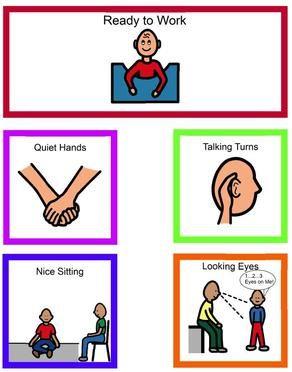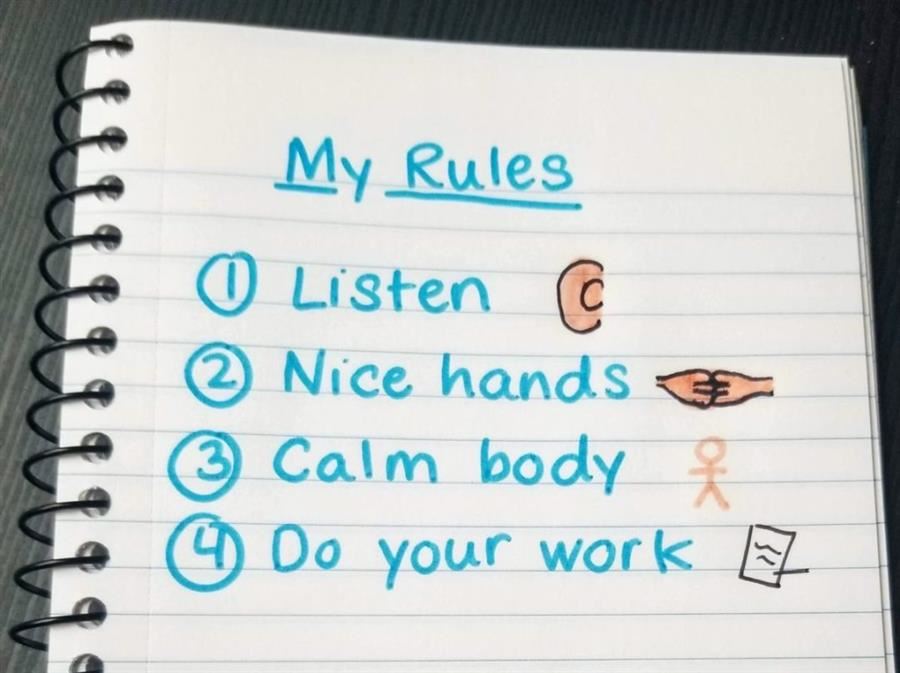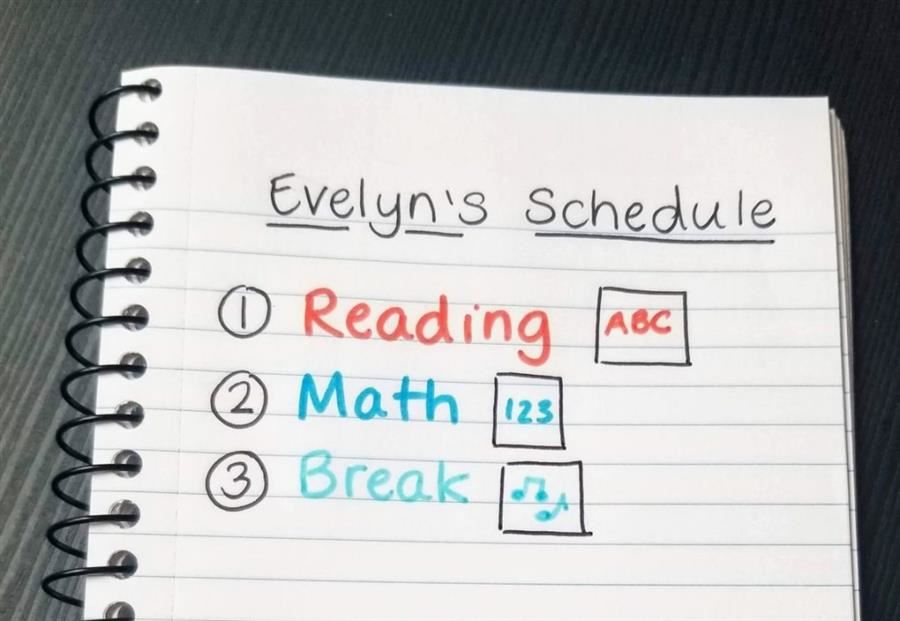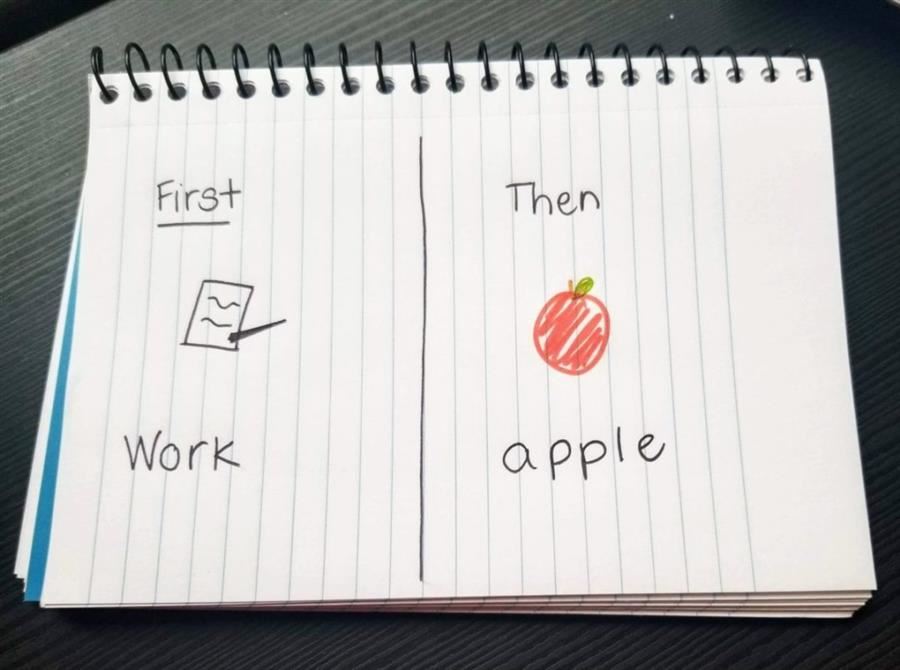-
Setting up Home Instruction for Students with ASD
A How-to Guide for ParentsCOMMUNICATE TASKS AND EXPECTATIONS CLEARLY
Many children with ASD are strong visual thinkers who process language differently. Like puffs of water vapor in the air, spoken language fades - it is here one moment and gone the next. Visual information "stays put" in a way that is helpful for our children who have difficulty attending to, remembering, or even fully understanding what people say. It is helpful to take a "show me" versus "tell me" approach for children with ASD.
Children with ASD can get overwhelmed with too much verbal information and struggle with understanding vague directions or figurative language (e.g., figures of speech). We can help by ensuring our language is concise, specific, and concrete.
HOW TO DO IT
Make it visual. There are countless ways to make information and directions visual. While you are explaining something to a child, try drawing and diagramming as you speak.
Some examples of making information visual include (1) volume meter to prompt appropriate voice level, (2) hand washing routine (3) rules during group work, (4) choice board to select what a child wants to earn, (5) a T-chart that teaching "ok" and "not ok" use of an iPad.

While many visuals used by educators are printed and laminated for use at school, your child will respond just as well to a visual that you illustrate by hand. Here are several visuals created by hand from the Autism Helper website (1) rules during schoolwork, (2) a schoolwork schedule, and (3) a first/then visual. Remember, visuals build independence by helping your child get information from their environment to know what to do. When they are ready, teach them to create their own "to do" lists just like we all do!
Refer to the first section Provide Structure and Predictability for additional guidance on how to ensure schoolwork so that it is visually clear for your child.
Use language that is concise, specific, and concrete. The table below provides examples of language that will generally be less effective versus more effective when speaking to a student with ASD.
Less Effective More Effective Indirect vs direct request "It would be helpful if you would get ready for math." "Get ready for math. Take out your blue math workbook and a pencil. Open to Unit 3 on page 27." Vague vs specific directions "Think about the story. Get some ideas down on the page about what happened." "Write three sentences. Each sentence should describe one event from the story, something that happened to the main character." Use of figurative vs concrete langauge "Where are you today James? You have your head in the clouds again. This is science time." "We are working on science right now. Stay focused. Think about your science project." Ironic, gentle sarcasm vs concrete statement "I'm sure you'll be heartbroken to find out there is no math work today" "You will be happy because there is no math work today." Cluttered vs concise direction "The first thing we are going to do is the supplemental math activity. After that I'm thinking you'll probably be up for a break." "First do the math activity. Then take a break." Stating what not to do vs what to do "Alex, no pushing" "Alex, keep your hands touching your sides." Language and teacheable moments. Parents can also take advantage of teachable moments when, for example, someone uses an idiom (e.g. "It's raining cats and dogs just means it's raining heavily", "Having a green thumb means a person is good at gardening"), or if someone is being ironic or sarcastic (e.g., "When your brother said, "Oh great turkey for dinner again, he was really saying that he is sick of eating turkey and wants something else"). Our students with autism benefit when we directly teach what other kids just seem to pick up on naturally, whether it's nonliteral language or social norms and expectations.
Break assignments and work down into achievable steps. Many children with ASD will struggle with open-ended assignments or prompts from their teacher. If the teacher asks students to "Write a story about a trip you have taken", it may be overwhelming. However, if we break into achievable steps and include "starter" sentences, the added structure will help some children complete the task. Graphic organizers can be used to break down and organize tasks to make them doable.
"I Do, We Do, You Do" to teach. This is simple and very effective teaching strategy that can be used to teach many skills. View the video below for an effective demonstration. However, we do want to recognize that some children with ASD may not have developed or are still working on the skills of attending and following directions. Parents are encouraged to find any way to involve their child in daily activities and routines at whatever level works for you and your child.
In Review...
➤ Make it visual. Whenever feasible, pair verbal information and directions with something visual.
➤ Use language that is specific, concise, and concrete.
➤ Break assignments down into achievable steps and use visuals to illustrate those steps.
➤ Use "I do, we do, you do" as a way of teaching your child skills and routines.
Additional Resources
Cooperative behaviour: children and teenagers with autism spectrum disorder
Comprehension of the Message: Important Considerations for Following Directions
Next page Tip 5: MANAGE CHALLENGING MOMENTS WITH POSITIVE BEHAVIOR SUPPORTS
 Setting up Home Instruction for Students with ASD
Setting up Home Instruction for Students with ASD
A How-to Guide for ParentsDeveloped by autism specialists at Columbia Regional Program
Email questions or feedback to crpweb@pps.net








